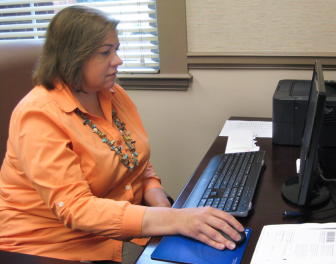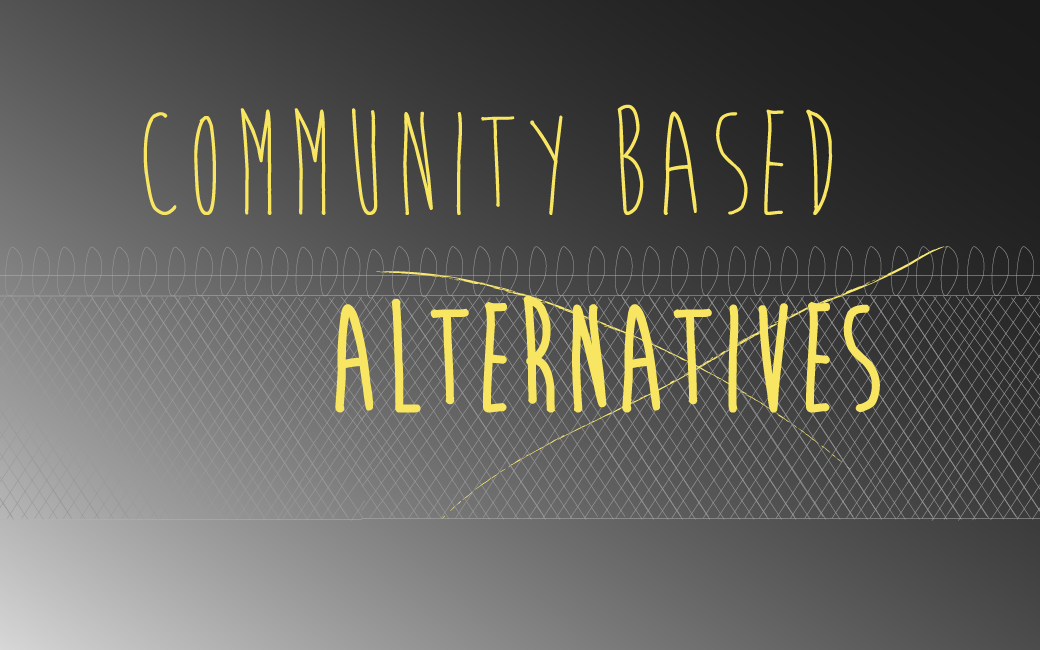
Katy McCarthy / JJIE
Editor Note: This story is part of a series of articles exploring Community-Based Alternatives. Readers may also be interested in visiting the Juvenile Justice Resource HUB for more information about community-based alternatives and the juvenile justice system.
COVINGTON, Ga. -- This small community to the east of Atlanta isn’t necessarily the kind of locale one would associate with progressive juvenile justice policies. Yet here, deep in the rustic Georgian countryside, the local juvenile court has embraced an innovative model where keeping kids out of trouble, the courtroom and especially detention has become an utmost priority.
Among the first of many detention alternative programs in Newton County was its specialized juvenile drug court, which officials say was the very first of its kind outside any urban area in the nation. Established in 1998, the court is still in operation nearly 15 years later.
 And in the county of approximately 100,000, it’s not the only so-called community-based juvenile diversion program, either. A restorative justice program, a truancy intervention program, a program designed specifically for female offenders and programs for both pre-adjudicated and post-adjudicated offenders are all up and running in the jurisdiction.
And in the county of approximately 100,000, it’s not the only so-called community-based juvenile diversion program, either. A restorative justice program, a truancy intervention program, a program designed specifically for female offenders and programs for both pre-adjudicated and post-adjudicated offenders are all up and running in the jurisdiction.
“The national data would tell you that any kind of child that has a detention, that first contact, it usually increases the likelihood that they will continue to offend,” said Juvenile Court Judge Sheri Roberts, who has sat on the Newton County bench for the last five years. “We think the outcomes for these diversion programs are definitely the way to go.”
Last year, 756 young people were referred to the Newton County Juvenile Court. Of those, 58 percent had their cases either dismissed or diverted.
According to Roberts, the purpose of the programs is simple: To keep youth out of juvenile courtrooms altogether.

James Swift / JJIE
Newton County Judicial Center, Newton County, Ga.
“You’re trying to just let that be the only contact,” she said. “Never let them have, really, court involvement and just get them back into the mainstream.”
She said the court’s many intervention services decrease the likelihood of program participants committing new offenses, and recidivism rates for some programs have dropped to single digits.
“The percentage of youth completing our truancy program that don’t offend is 91 percent,” Roberts said. “You’re not going to get those kinds of results if you just start locking them up.”
In 2012, Georgia’s Department of Juvenile Justice budget approached $300 million, with about two-thirds of funds invested in secured incarceration or detention. Some national reports have even assessed the 20-year cost of maintaining just one bed at a secured juvenile facility as high as $1.5 million. With more and more states abandoning the practice of detaining and confining juvenile offenders in secured facilities -- a costly practice that has also been criticized as ineffective at preventing crime or rehabilitating young people -- the cost-efficient, evidence-based diversion programs implemented by this one, small Georgia community may serve as a model for a national system desperately seeking reform solutions.
“We Don’t Take Low-Risk Kids”

James Swift / JJIE
Tiffany Collier, a drug court case manager in Newton County, Ga.,
Drug court case manager Tiffany Collier said that about a dozen children are currently enrolled in the program.
“They come to court every other Tuesday to appear in front of the judge and see what they’ve accomplished within that timeframe, or anything that they’re having problems with,” she said.
All program participants meet in group sessions once or twice a week where they learn various coping skills. Children who turn in negative drug screenings are rewarded with shopping gift cards, and participants having other difficulties, such as trouble with their school work, receive tutoring and other assistance. The Social Empowerment Center, a privately-owned service based in Lawrenceville, Ga., has partnered with Newton County to provide counseling for the program.
The drug court program is available to kids between the ages of 12 and 16. Youth enrolled in the program are required to serve at least 12 months in the program, but due to periodic relapses, the average participant may spend up to 15 months in the program.
In 2012, the program had 37 participants. At the beginning of 2013, 18 remained active participants in the program, eight had been removed or withdrawn from services and 11 have graduated, none of whom have so far re-offended.
Currently, the program is funded by the Governor’s Office of Children and Families (GOFC) and by a grant from the Criminal Justice Coordinating Council (CJCC). The program was expanded last year to Walton County, which shares the same judicial circuit as Newton.
“We don’t take low-risk kids that have just made a mistake,” Roberts said. “We take kids that are actually using and abusing, that are showing indicators of potential long-term addiction.”
The program consists of five levels, she said, and employs a “sanctions and incentives” model. The first level of the program requires the most supervision, with participants reporting to group therapy two, and sometimes three, times a week. During the earlier portions of the program, participants are required to come to court every other week, and staff conduct regular drug screenings. As teens progress through the program they are allotted more freedom, but if they make a misstep, such as a curfew violation or test positive for drugs, they receive a sanction, according to Roberts.
“When they do well, we reward them with things like giving them cell phones back, or drivers licenses back,” she said. “Most kids can tell you what it is they want most.”
One Detention Alternative, $286,000 in State Savings
Last year, the Newton County Juvenile Court created the Evening Reporting Center (ERC), a detention alternative program initially serving pre-trial male offenders. Since then, however, the program has been expanded to include not only separate programs for boys and girls, but also programming for post-adjudicated juveniles.
In the ERC, which serves juveniles ages 11 to 17, the four groups rotate through several units, which include life skills programming, tutoring and recreational activities, all of which are anchored around weekly themes.
Occasionally, Roberts said, the state Department of Juvenile Justice sends children to the center, instead of filing probation violations. “They can ask if a kid has gone through all their graduated sanctions,” she said, “[and] they have the kid go there for a week for a certain course.”
In 2012, 170 kids participated in the ERC, enrolled an average of eight or nine days. All but nine graduated, and an estimated 80 percent have not re-offended.
At about $122 a day, enrolling a child in the ERC costs less than half as much as housing a youth at the nearest Regional Youth Detention Center (RYDC), which costs $260 per day. According to a Newton County analysis, by placing children in the ERC program instead of detention, the county last year saved the state approximately $286,000.
Nationally, the Justice Policy Institute pegged the total annual cost of juvenile detention and confinement in 2009 to be nearly $6 billion. Were a state like Maine or Mississippi to adopt a statewide, detention-alternative similar to Newton County’s ERC program, the daily savings could range from $32,000 to $46,000 per day; and if states such as California or Michigan enacted such programming, the savings could run from $302,000 to $413,000 daily.
“In these various groups, we use evidence-based materials,” Collier, a Life Skills Group Facilitator for the program, said. “I do a lot of hands-on learning, so I might have different games to play and when I go to talk to them about it, I wrap it up into the topic that we’re doing.”
Children enrolled in the ERC attend four classes a day, five days a week. Each course runs anywhere from 45 minutes to an hour. Every week, a different topic is emphasized, Collier said, including themes such as decision-making, anger management and social skill development.
“If they’re pre-trial, they’ll wait until their court date,” she said. “If they come from DJJ, they usually assign them maybe a week or two, depending on their sanctions.” Court-ordered youth, she added, are usually in the program from two to three weeks.
“DJJ does send a lot, but the kids have to have the sanction in order to be sent,” she said. Most referrals, Collier concluded, come from either court orders or the Balanced and Restorative Justice program, another detention-alternative service provided by the Newton County Juvenile Court.
Some Successes, Some Failures
In 2010, the Newton County Juvenile Court began the Girl STEPS program, a female offender-focused service. “The trend, here and nationally,” Roberts said, “is we’re seeing more girls commit offenses and they’re committing higher level offenses.”
The group-based program involves about a dozen girls per unit, and requires family participation. “It’s a pretty thorough and intense curriculum,” Roberts said. “It’s built around an accountability court model, so they do come to court ... Over the six months, I think it’s about four times.”
Like the county’s drug court program, the Girl STEPS program uses an “incentives and sanctions” model.
“If they’re doing well, we praise them and reward them,” Roberts said. “If they’re having a few bumps, it also gives us some interaction with the parents so we can encourage them.”
Program participants may also receive referrals to psychological or counseling support services. The Social Empowerment Center, which also provides counseling services for the Newton juvenile drug court program, partnered with the county to be the core delivery provider for Girl STEPS.
Last year, 30 girls participated in the program, and approximately 92 percent of graduates have not re-offended since leaving the program.
The Newton County Juvenile Court also makes use of several informal adjustments, as well as community service programs. During Roberts’ tenure, however, several community-based programs have been axed, including Project Target, a boot-camp diversion program.
“I dismantled that day one,” she said. “It’s ineffective, it does not actually produce any positive outcomes. It’s too akin to ‘Scared Straight,’ [which] the data says does not work.”
One program, CLASS, was designed to be a boys alternative school program. The intent, Roberts said, was to transition the program into the Newton school system.

James Swift / JJIE
Judge Sheri Roberts.
“As tax revenue dropped,” she said, “the system decided to disband the alternative school. They went with Ombudsmen, which is a contract provider for a part-day school.”
The funding for CLASS was something the local school board simply couldn’t absorb.
“There was no place to transition it to,” Roberts said. “We hated to see that program go, and there’s a very high need for it.”
“Funding to Continue Doing What We’re Already Doing”
The signing of House Bill 242 earlier this year, a piece of legislation that rewrites Georgia’s juvenile code, and commitments from Gov. Nathan Deal to place a greater emphasis on juvenile detention alternatives, mean there is a very strong chance the programs that Newton County has used for years may soon spread to other areas of the state. But ironically, Roberts believes rural counties like Newton won’t benefit immediately from increased detention-alternative funding.
Learn more about Community-Based Alternatives at the Hub
“The criteria to participate in the first round of funding was that you needed to reduce your short-term program admissions and your commitments by 20 percent,” she said. “When you looked at the data, and the lowest level of funding from the governor’s pool was $100,000, I would have to reduce those two items by two children.”
Reducing the population in those categories by two juveniles, she said, was not an economically viable option. “We just have to work harder, and continue to use and improve these programs,” she said.
While she does not believe that state funding is likely to trickle down to jurisdictions in similar size to Newton County, she does believe a funding shift is likely to occur as improvements are made statewide.
“Right now, it’s just grant driven -- hit the targets, let’s make these changes, get these programs in your community,” she said. “But then you’ll see the cycle of reinvestment, and that’s when the rest of us will have some funding to continue doing what we’re already doing.”
The initial funding impact from HB 242 will likely be negligible for the state’s less-populated counties -- which, according to Roberts, are already likelier to rely on detention due to a lack of alternative programs. “There’s a lot of areas in Georgia that are so rural, there’s not resources to help divert, that don’t have detention alternatives,” she said. “And I think through this first grant cycle of the funding, it’s going to be for the larger jurisdictions.”
Waiting for the Synergy
Many jurisdictions, Roberts said, have difficulties implementing community-based alternatives for a number of reasons, among them, the pressures of more court oversight, greater needs for judicial leadership and understaffing.
“Many juvenile courts, certainly, don’t have grant writers or researchers or anything along those lines,” she said. “Just the oversight and the implementation can be a challenge, if it’s court-driven.”
Even so, Roberts believes if the state fully embraces the idea of detention alternatives, including quality services and evidence-based practices, Georgia would see dramatic juvenile justice costs savings. The burden, especially for smaller courts, could be eased with more Department of Juvenile Justice involvement, she said.
“If it becomes more driven by DJJ as a partner, that could make some of those things a lot easier, because they would have more staff and resources,” she said.
With more interaction and exchange of information between courts and counties, she said there is a greater likelihood more diversion programs will crop up across the state. “There’s a lot more knowledge out there, and I think as these programs start to develop, then if it’s in one place, maybe the two surrounding counties will be able to join that process,” she said. “We’re just going to have to see how that synergy happens.”
Asked why she believes more counties in the state don’t implement community-based alternative programming, Roberts blames a lack of resources.
“If you have a judge that has a seven county circuit, and doesn’t have any staff, what are they supposed to do?” she said.

